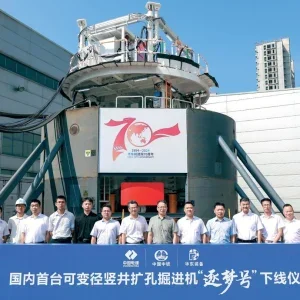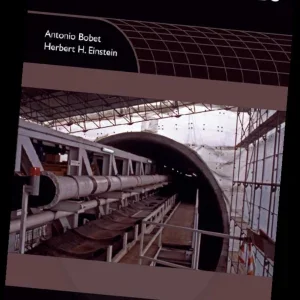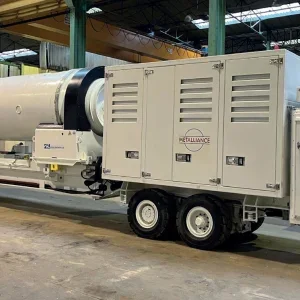Shinkansen is the name of the world-renowned high-speed rail system in Japan – similar to the TGV in France or ICE in Germany. The system has been extended across the whole of Japan, with the Hokuriku Shinkansen being one of the extended lines (Figure 1).
The Hokuriku Shinkansen covers a 690km stretch from Tokyo to Osaka through the Hokuriku region in the central part of Honshu island. A section of around 125km of the line connecting the city of Kanazawa and the city of Tsuruga has been under construction since 2012. Its inauguration, now scheduled for spring 2024, was delayed by various procurement procedures to do with local construction resources and rights of ways.
The civil structures of the extension consist largely of tunnels excavated by the New Austrian Tunnelling Method (NATM), including drill and blast, and boom-type roadheader. Among these structures, the Shin- Hokuriku Tunnel is around 19.76km long, the longest tunnel on the extension. Length is not the tunnel’s only interesting characteristic, but also the terrain through which it must pass, characterised by extremely soft geology and fissures, as well as passing beneath an existing highway tunnel.
With an inner cross-section of 70m2, the tunnel contains twin rail tracks that will carry the 3.4m-wide Shinkansen train cars. The tunnel was divided into six construction sections, all of which have been excavated by NATM. Construction work started in 2015 and completed in 2020.
GEOLOGICAL CHALLENGES
Figure 2 shows the geological profile along the tunnel alignment; the most notable characteristics of this tunnel are the geological challenges. First, the ground consists of complex, alternating strata containing chert, sandstone, granite, and slate. During excavation, the alternating strata were expected to result in frequent instances of extremely soft and weak soils. Second, the tunnel crosses fault lines on multiple occasions, resulting in frequent changes of geology. In particular, the tunnel crosses the most dangerous fault crush zone called Yanagase, which had been confirmed as an active fault by the preceding tunnelling for the highway. Furthermore, tunnelling near the fault zones with an overburden of more than 500m encountered fissures containing large amounts of pressurised groundwater. This water had been anticipated during the geological survey for the highway tunnels. Indeed, during their excavation, several inrushes of water had been observed in this area which seriously impacted the tunnelling.
PROBE BY DRILLING
Delays in excavation pose a huge risk for long tunnels that must be constructed in a limited time period. In order to ensure a trouble-free tunnelling process, probe drilling by tunnel jumbo was used prior to the main excavation in order to select the most appropriate auxiliary method(s).
The softer the ground, the faster or easier the drill penetrates. In other words, less energy is required to drill into softer ground. Thus – since the advent of mechanised tunnelling – drilling probes have traditionally been used to gauge ground hardness. In our tunnelling application, this drilling energy was measured precisely to examine the forward geology securely, and the data fed back to determine excavation and auxiliary methods. Specifically, driving force and rotating force were able to be measured in the drill jumbo’s cab. The accumulation of those forces can provide an idea of total consumed energy for the probe drilling. Accumulated values are considered to indicate the geologic property of the ground, so comparisons between the data of drilling energy and the tunnel deformation after excavating would show some correlation. After verifying the drilling energy with the actual measured deformation, this probe could more precisely predict the forward geology.
FAULT CRUSH ZONE
At the start of excavation, probing by elastic wave and drilling were undertaken to confirm the existence of the soft geology ahead of the cutting face. At locations with possibilities of serious water inrush, electromagnetic wave probe was also used. Despite these advancing probes, large-scale collapse of the cutting face by water inrush occurred at the first fissure zone. When excavating through a fault crush zone directly below the first existing highway tunnel (outbound), crushed clay and a high amount of high-pressure water flowed simultaneously into the tunnel. With the waterflow mixing with the clay, the cutting face almost turned into a mudslide, after which excavation was suspended for a few weeks.
Based on this experience, additional measures against collapse from water were studied. Lowering the ground water level was the first option, and core boring was added to the above-mentioned preceding probes for both probing and draining. However, the bore hole collapsed so easily at the soft fissure zone that core boring was frequently suspended. To counter this phenomenon, steel pipe was inserted in the hole to drain the water securely. As for excavation progress at these serious fault crush zones, short- and long-forepoling (and face bolts) were used as auxiliary methods to stabilise the cutting face. The length of forepoling was determined by the result of core boring, probe drilling and observing the soil at the cutting face.
CLOSE TO EXISTING HIGHWAY
Another feature of tunnelling in the fault crush zone is its proximity to the existing highway. The Shinkansen tunnel alignment is located 65m below the highway’s outbound tunnel and 43m below its inbound tunnel, crossing at an angle of 42 degrees.
To counter the challenging geology, the Finite Element Method (FEM) was used beforehand to assess the amount of settlement and pressure on the tunnel lining. A settlement limit of 25mm for the highway road surface was requested by the highway administrator during negotiations. To inhibit the settlement within the limit value, the value for the maximum settlement of the Shinkansen tunnel was calculated as 27mm. In this case, the expected settlement of the road surface in the highway tunnel is 18mm, as shown in Figure 3. This value was calculated by using FEM analysis, assuming the tunnel lining thickness to be 150mm, with primary invert concrete and long steel forepolings applied.
However, face bolts were also prepared in case of excessive settlement.
The primary invert concrete was to be cast before installing the permanent invert concrete. Usually, invert concrete mainly has two purposes: early closure of the tunnel ring and to inhibit disturbance of the roadbed. For the latter reason, invert concrete was installed after deformation of the surrounding soil had ceased. However, in the case of vulnerable ground, ring closure should be the most prioritised reason, and the invert concrete had to be cast before progressing the deformation. Particularly for this tunnel, a fault zone of such softness was expected that the earliest closure of the tunnel ring was indispensable. For this reason, shotcrete for the lining was also sprayed in the invert area to form the primary invert concrete. In this way, the tunnel ring can be closed in the shortest distance from the cutting face, around one diameter of the tunnel (10m) behind the cutting face. After excavation progressed to some extent, permanent invert concrete was cast on the primary invert concrete. Naturally, the permanent invert concrete was not shotcrete.
During excavation within the fault crush zone – 65m before crossing the first highway tunnel – it was observed that crushed soil and high volumes of high-pressure water were flowing simultaneously into the tunnel, as expected (Images. 1 & 2). Excavation beyond this point was anticipated would have a serious impact on the highway, so intense care and adherence to safety were required. In addition to using steel forepoling and long steel face-bolts as auxiliary methods, the primary concrete invert was installed to close the lining ring within three days of excavation to minimise the distance between the face and the invert concrete (Figures 4 & 5).
ACTUAL SETTLEMENT AFTER EXCAVATION
The actual maximum contraction of the inner tunnel diameter measured at the crossing point with the highway in the fault crush zone was approximately 100mm. However, actual settlement and measured force on the lining concrete were both smaller than the expected values obtained from FEM analysis. The effective combination and application of various auxiliary methods and careful construction work could constrain to a minimum the range of soil plasticisation caused by excavation work to minimise the influence from the natural ground.
FOR THE FOLLOWING EXCAVATION
Even after the completion of the Shin-Hokuriku Tunnel in 2020, there are still some other challenging tunnels on the extension line which are currently being excavated. For these, alternating geology and high-pressure water are also expected. Some of them have suffered invert heaving caused by soft soil and ground water. Though the condition of natural ground rapidly changes during excavation, a careful and safe approach to construction work is maintained to result in robust tunnel structures with no injuries.
The experience and know-how acquired from the excavation of the Shin-Hokuriku Tunnel will be fed back via post-work assessment to inform forthcoming challenging events in these tunnels. Moreover, the experience gained from tunnelling will also serve as a good reference not only for new projects in Japan but also those worldwide. With the gradual demise of the pandemic, intense exchanges of information and know-how are expected at the International Tunnelling Association (ITA).
The new Shinkansen Project has been inspired by local people living along the line as an effective trigger of economic development. In such a situation, JRTT as the developer of high-speed rail infrastructure, typically works to very tight schedules to implement projects from preliminary survey to completion. During such projects, especially in tunnelling, JRTT carefully and appropriately deals not only with excavation but also with environmental issues, including the sinking of wells, construction noise and muck disposal.
Such associated situations can place our construction work under duress, especially when it must be completing quickly while paying consideration to the immediate environment and the future sustainable management of the tunnel. JRTT is keen to share its experience of such challenges with tunnelling professionals globally.






